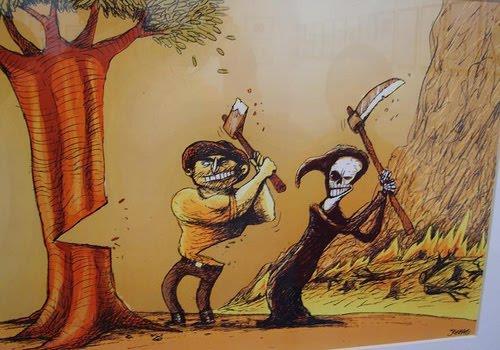
Gold Fever in Crucitas: A Mining Project Versus The Environment
(MENAFN- Costa Rica News) Central American countries have always suffered endless depredation of their natural resources. Those who perform such actions do so with no regard for the negative impacts that they generate. In this entire region, emblematic mining projects with serious social, economic andenvironmental damagecan be observed as a result for example, of open-pit and artisanal mining.
Many of us have asked, what happened to the
'Crucitas' mining project, in the district of Curtis, canton San
Carlos, in the province of Alajuela, Costa Rica? Let us remind you that through
this mining exploitation, severe damage to the San Juan River Binational Basin,
located between Costa Rica and Nicaragua, has been caused in an area rich in
biodiversity.
The first 'coligalleros or guriseros'
(miners who steal gold in small quantities), originally a legal activity for
being supposed of artisanal matter, came to the area of Abangares, Guanacaste,
Costa Rica. Subsequently, gold fever caused the massive invasion of people in
search of fast fortunes and adventure that was quickly diluted.
In recent years, those who pass through the Crucitas sector, according to studies, are Nicaraguan guriseros, most of them illegally. As mentioned earlier, mining activities have been carried out in Crucitas, when at first just one open-pit mine operation was opened. Now it has been extended to approximately 20 in the area. The exploitation takes greater force in 'El Pantanal', another sector (about 200 meters from Crucitas), considered as a wetland, causing severe damage to the natural grounds, both externally and internally.

The exploitationhas generated clearly visible damage to any person who wishes to visit these places, including: the total loss of the tropical humid primary forest, the widening and deterioration of natural water current drainage, the generation of many tons of dispersed tailings material, the change of use of soils, which gives rise to the presence of weeds and scrubs, acids accumulation, abundant residues of solid waste and feces and visual contamination.
Specialists in the subject have explained that during
the process to obtain gold, mercury is used, which is why soil and water
pollution is evident; waters and sediments drain contaminated with tons of
mercury to Caño Crucitas and the Infiernillo River, whose surface waters flow
into the San Juan River, Nicaraguan territory. The process used with gold is
called 'tombola', in which an average of 2 to 3 ounces of mercury per ton is
dispersed. Allegedly, more than 100 'tombolas' are being used daily in the
border sector of both countries (Nicaragua-Costa Rica).
Actions in this situation
For no one is a secret what has been happening with Crucitas, the illegal exploitation of gold for years, violation of environmental laws, threats to people's health, transfer of prohibited substances like mercury in addition to cyanide, and the looting of the mineral riches of the subsoil. In Cutris, the crisis accumulated months after the Canadian company Infinito Gold, endorsed by the government of Oscar Arias, started and then abandoned a mine there.
Based on these facts, the Ecological Federation (Fecon) this year 2019
has introduced a lawsuit to the National Constitutional Court due to the
inaction of the Ministry of Health and Environment. Mainly the action is based
on 'Mercurial Contamination'. In 2018, Fecon filed a complaint with the
Ministry of Health for the same contamination with mercury, requiring the
authorities to lay responsibilities on the owners of the lands involved in the
environmental damage of the area. 'Mercury is classified as a highly toxic
substance that poses special public health problems according to the World
Health Organization.
This year 2019, the Costa Rican police have carried out the military
operation known as 'Lapa 3', with the aim of expelling the guriseros, both 'Ticos
and Nicas'. The result was the capture of more than 200 illegal miners.
Undocumented people were handed over to the migration authorities at the Las
Tablillas border post. The police managed to seize 5 vehicles with Costa Rican
license plates, in addition to rustic equipment used in mining, which is kept
guarded by the Border Police. In that sense, the Minister for the Environment,
Carlos Manuel Rodríguez, said that there is the possibility of carrying out the
environmental fine procedures for $ 600,000 to deal with the damage caused to
the use of mercury at Crucitas.
The coordinators of the organization 'Ni Una Sola Mina' (Not a Single
Mine), denounced a while ago, that 'the Government has failed to control,
intervene and much less eliminate metal mining in Costa Rica, saying that there
is no will by the authorities to solve this serious national problem and that
clear open complicity is evident by the State with existing projects, as well
as the economic interests related to them, including those that have to do with
'coligalleros'. 'Ni Una Sola Mina' denounces: 'It is false that Costa Rica is a
mining-free country and political actions have been far from ending such
long-standing problem'.
What happened in 2010?
On
November 25, 2010, it was learned that the Costa Rican Supreme Court of Justice
ordered the cancellation of the Las Crucitas project mining concession. At that
time, a controversy was generated by the open pit gold mine that was intended
to be opened. The court annulled the decree of former President Óscar Arias in
which he declared the Crucitas mining project of 'public interest',
which led the prosecution to open a legal case against the former president and
several of his officials for this action. In addition, the judges ordered the
State and the Canadian multinational Infinito Gold, owner of the project, to
pay compensation for the environmental damage caused by deforestation in the
initial work of opening the mine. The Infinito Gold
Company had begun exploration in the Las Crucitas area in 1995. The mining
project aroused the rejection of most Costa Ricans, led by environmental
organizations, causing the legal actions that eventually took place.
A look towards all of Latin America
Unlike underground mining, open-pit mining is developed on the surface
of the land and for its exploitation, it is necessary to excavate, through
explosives or with mechanical means, the lands that cover or surround the
geological formation that forms the site causing ecological havoc.
The situation in Costa Rica is closely observed by
other countries where there are controversial mining projects such as
Argentina, Peru, and Bolivia. In this regard, environmentalists in general,
point out that open-pit mining alters severely the ecosystem and endangers the
main sources of freshwater.
From TCRN we say that this is a case that should have more attention from all conscience minded citizens, for the respect for our natural environments and the future off all the inhabitants of this land.

At Resonance, we aspire to live in harmony with the natural world as a reflection of our gratitude for life. We are co-creating an inspired and integrative community, committed to working, living and learningtogether. We resonate with that deep longing to belong to the hive and the desire to live the highest version of ourselves in service.

Legal Disclaimer:
MENAFN provides the
information “as is” without warranty of any kind. We do not accept
any responsibility or liability for the accuracy, content, images,
videos, licenses, completeness, legality, or reliability of the information
contained in this article. If you have any complaints or copyright
issues related to this article, kindly contact the provider above.


















Comments
No comment